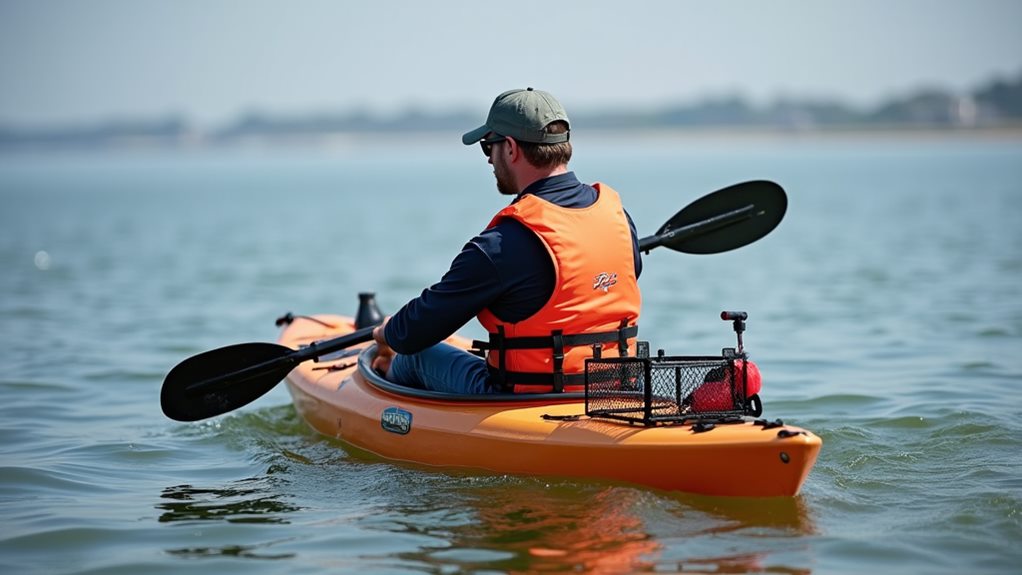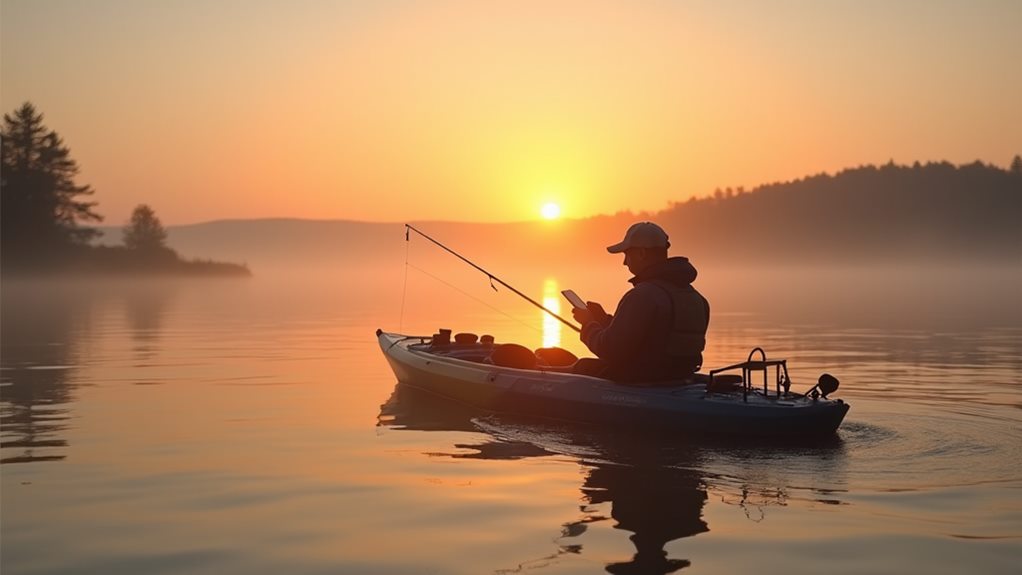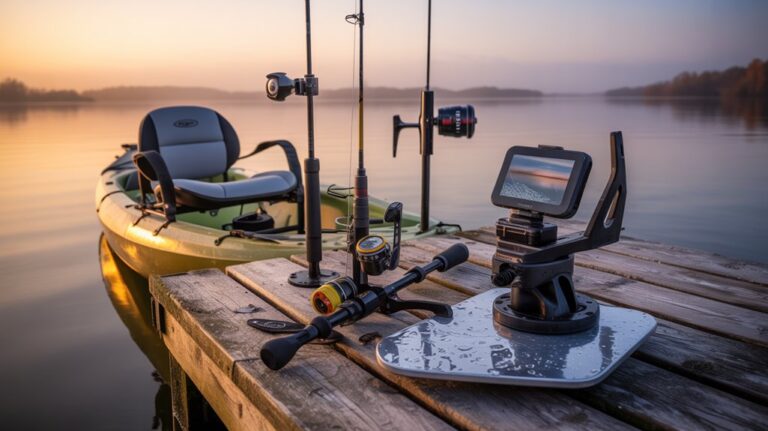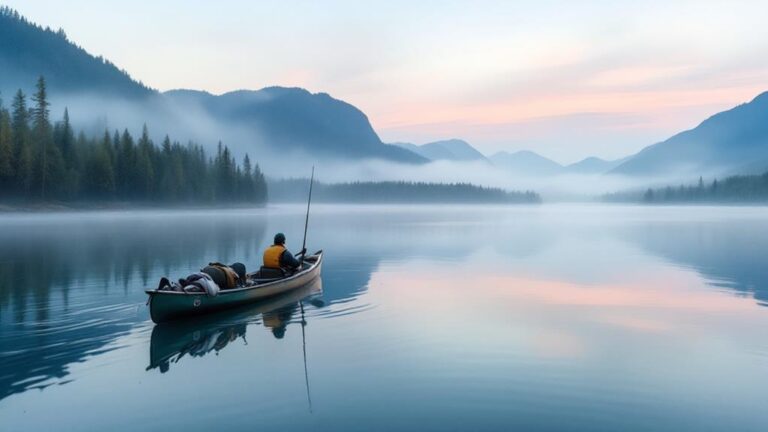Start your kayak fishing journey by prioritizing safety with a proper PFD and crucial gear like whistles and waterproof storage. You'll want a stable sit-on-top kayak between 10-12 feet long with built-in rod holders and adequate storage space. Master basic paddling techniques in calm waters before tackling challenging areas, and verify you've got the right fishing setup with a compact tackle box and sturdy rod holders. Scout local waterways for prime fishing spots near natural structures, and always check weather conditions before heading out. With these fundamentals in place, you'll discover a world of exciting angling adventures awaits.
Safety First: Essential Equipment

Three vital pieces of safety equipment stand between a successful kayak fishing trip and potential disaster. First and foremost, you'll need a properly fitted Personal Flotation Device (PFD). Don't compromise on this important item – the U.S. Coast Guard recommends wearing it at all times while you're on the water, regardless of your swimming ability or experience level. Additionally, being aware of your surroundings and employing eco-friendly practices can enhance both your safety and enjoyment while kayak fishing.
Next, you'll want to pack extensive safety gear for communication and visibility. Keep a whistle or horn within easy reach to signal for help if needed. When fishing in low-light conditions, include visual distress signals like flares or strobe lights to guarantee other boaters can spot you. A bilge pump is another vital tool you shouldn't overlook, as it helps remove unwanted water from your kayak and maintains stability.
Choosing Your Perfect Kayak
With safety gear secured, let's focus on selecting your ideal fishing kayak. When choosing the right kayak for your angling adventures, stability should be your top priority. Opt for a sit-on-top model that's between 10 to 12 feet long, as this design offers the perfect balance of tracking ability and maneuverability. Additionally, consider where you'll be fishing; for instance, top kayak fishing locations often dictate the features you need in a kayak.
Here are important tips for evaluating fishing kayaks: First, verify the kayak's weight capacity can handle both you and your gear comfortably. You'll want built-in rod holders and ample storage space for your tackle boxes to keep everything organized and within reach. The sit-on-top design isn't just about easier entry and exit – it's essential for standing stability when you're casting or landing that big catch.
Don't rush your decision – take advantage of demo days and rental opportunities to test different models. You'll want to feel confident and comfortable in your choice since you'll be spending hours on the water. Remember, while there are many fishing kayaks on the market, the best one for you is the one that matches your specific fishing style and physical capabilities.
Paddling and Navigation Skills

Along with having the right kayak, mastering proper paddling techniques is vital for successful fishing excursions. Your ability to navigate effectively while maintaining control of your vessel can make the difference between a productive day and a frustrating experience. Start by selecting a paddle that's around 250 cm in length, which will give you ideal reach and comfort during your adventures. It's also beneficial to choose a kayak that offers stability, such as a sit-on-top kayak, which allows for easier movement while fishing.
As a kayak angler, you'll need to master these fundamental techniques:
- Forward and reverse strokes for basic movement control and positioning
- Sweep strokes for making wide turns and adjusting your course
- Draw strokes for sideways movement when approaching fishing spots
Before heading out, familiarize yourself with local waterways and current patterns. Understanding your environment helps you navigate more efficiently and locate prime fishing spots. You'll also want to stay vigilant about weather conditions and nearby boat traffic. Practice your paddling skills in calm waters before venturing into more challenging areas. Remember that precise control in tight spaces is vital when you're casting, so work on developing your vertical strokes and fine-tuning your maneuverability skills.
Must-Have Fishing Gear Setup
Now that you've mastered basic paddling skills, proper gear selection will greatly impact your kayak fishing success. Start with a well-fitted personal flotation device that includes pockets for crucial safety items like a whistle and knife. You'll want to wear it at all times while on the water, so choose one that's comfortable and allows freedom of movement.
Mount sturdy rod holders to your kayak to keep your fishing rods secure and within easy reach while you paddle or handle fish. This setup allows you to maintain control of your kayak while accessing your gear efficiently. A compact tackle box is vital for organizing your lures, hooks, and other fishing equipment – you'll want quick access to your gear without creating clutter in your limited space.
Don't forget to protect your valuable items with waterproof bags, as splashing and unexpected waves can quickly damage electronics and personal belongings. Choose a lightweight paddle, around 250 cm in length, to reduce fatigue during long fishing sessions. The right paddle will help you maintain control and maneuverability while positioning yourself for the perfect cast.
Finding Prime Fishing Spots

Successful kayak fishing begins with locating productive spots that other anglers might overlook. Start by researching local waterways through fishing apps and connecting with kayak fishing communities to gather intelligence on promising locations. You'll want to focus on areas that feature natural structure, as fish often concentrate around submerged rocks, fallen trees, and vegetation edges seeking shelter and food.
- Study current patterns and depth variations in your chosen waters, as fish frequently gather where these elements intersect, creating prime feeding zones
- Begin with familiar fishing spots to develop your understanding of seasonal patterns and build confidence in your kayak fishing abilities
- Leverage local fishing reports and community insights to stay informed about active species and trending locations
While exploring new waters, pay special attention to less accessible areas that shore anglers can't reach. These untapped spots often hold the best potential for successful catches. Remember to note specific markers and GPS coordinates of productive areas you discover, as they'll likely produce results during future trips when conditions are similar. Your kayak's mobility gives you a distinct advantage in reaching these hidden honey holes.
Basic Casting Techniques
Mastering proper casting techniques from a kayak requires a different approach than shore fishing. Your position on the water demands attention to balance and precision to avoid tipping while casting. To develop these crucial fishing tips, start practicing your casts while seated in your kayak in calm conditions.
| Technique | Benefits |
|---|---|
| Overhead Cast | Maximum distance and accuracy for open water |
| Sidearm Cast | Better kayak stability in windy conditions |
| Short Cast | Ideal for developing control and balance |
| Smooth Cast | Reduces water disturbance and noise |
Focus on maintaining a slight upward trajectory when casting to guarantee your lure lands softly on the water's surface. This gentle approach prevents spooking nearby fish and improves your chances of success. Choose a medium-action rod for enhanced sensitivity and better distance control while you're perfecting your technique.
As you build confidence, gradually increase your casting distance and experiment with different casting techniques. Regular practice sessions, either on land or in calm waters, will help you develop muscle memory and improve your overall kayak stability. Remember to keep your movements fluid and controlled to minimize excess motion in your kayak.
Weather and Water Conditions

Safety on the water hinges on understanding weather and water conditions before you launch your kayak. You'll need to check the weather forecast religiously, as sudden changes can transform a peaceful paddle into a dangerous situation. Strong winds and storms aren't just uncomfortable – they can quickly create hazardous conditions that put you at risk.
Understanding water temperatures is essential for successful kayak fishing. Most fish are most active when water temperatures range between 60°F and 75°F, so you'll want to plan your trips accordingly. Water clarity will also affect your fishing strategy – if you're dealing with murky water, opt for brighter lures that fish can easily spot. In clear water, choose natural colors and make stealthy presentations.
- Plan your fishing trips during prime hours (early morning or late afternoon) when fish are most active due to cooler temperatures
- Monitor water levels and currents before and during your trip, as these factors greatly influence fish behavior
- Always carry navigation tools like maps or GPS devices to track your location and fishing spots effectively
Frequently Asked Questions
How to Fish From a Kayak for Beginners?
You'll need a stable fishing kayak, proper safety gear, and basic paddling skills. Start with simple equipment, practice in calm waters, and always wear your PFD while learning to cast and maneuver.
What Is the Best Bait for Kayak Fishing?
You'll find success with frogs, Texas rigged plastics, and Neko rigs. Don't forget scented soft plastics and topwater lures like poppers. In murky water, use bright-colored baits for better visibility.
How to Kayak Properly for Beginners?
Start in calm waters, keep your back straight, and center your weight. You'll want to master basic paddle strokes and maintain a stable posture. Don't rush – practice entering and exiting until you're confident.
Do Fishing Kayaks Flip Easily?
No, fishing kayaks don't flip easily. You'll find they're designed with wider hulls and better stability than regular kayaks. When you maintain proper balance and follow basic safety practices, they're quite stable.
Final Thoughts
You're now equipped with the fundamentals of kayak fishing. Remember your safety gear, choose a suitable kayak, and master those paddling basics. Don't forget to start with calmer waters and gradually build your confidence. Keep practicing your casting techniques and stay aware of weather conditions. With these tips in mind, you'll be reeling in fish from your kayak like a pro in no time.




